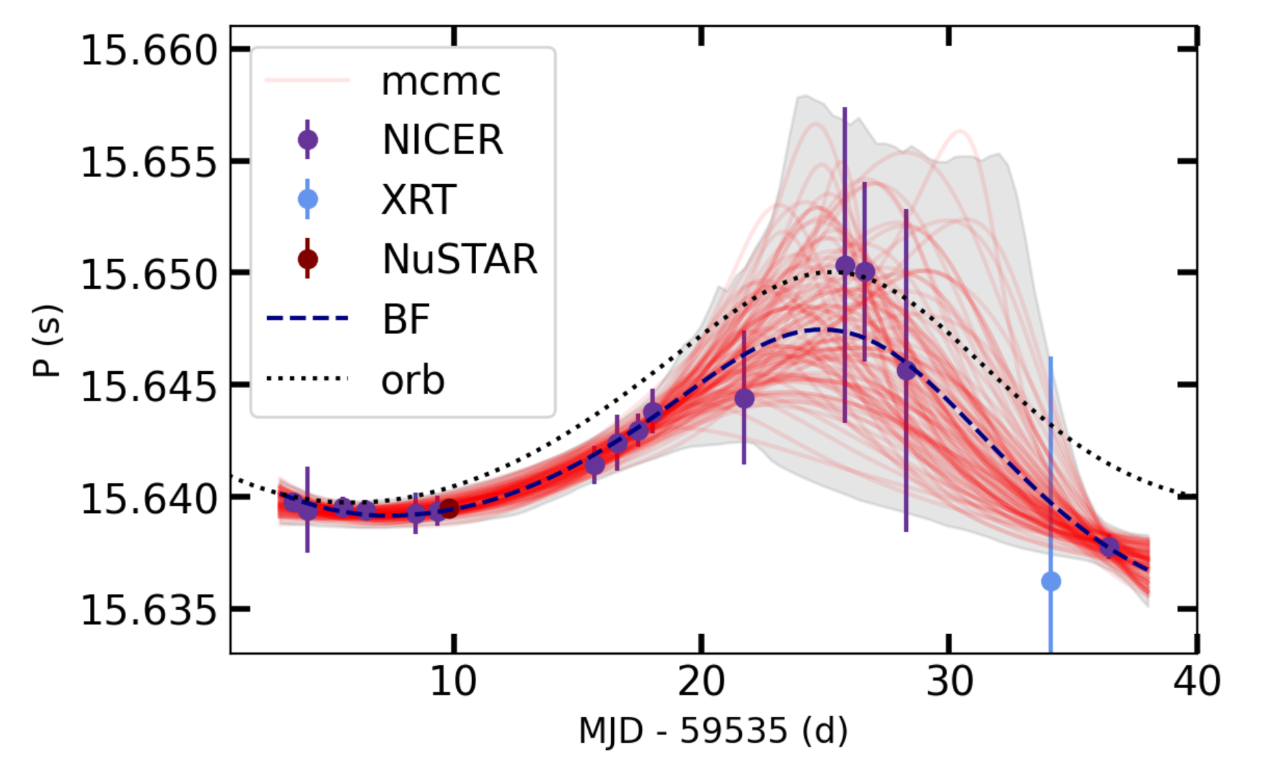NICER / ISS Science Nugget
for July 7, 2022
A Pulsar's Eccentric Orbital Habit
Among the Milky Way's neighbors, the Large and Small Magellanic Clouds are dwarf galaxies that stand out for being relatively nearby - at approximately 200,000 light-years distant - and for having populations of stars that differ from that of our own Milky Way. One such difference is the abundance of high-mass X-ray binary (HMXB) pulsars, especially in the SMC. These systems, which consist of a neutron star in orbit with a high-mass companion star, reveal themselves in episodic outbursts thought to be triggered by the close approach of the two stars in their elliptical orbits around a common center of mass. Where the companion star emits an equatorial wind, the neutron star's passage through this gas can lead to enhanced capture, or accretion, of matter, which emits X-rays as it is channeled into a column of hot gas near the neutron star's magnetic poles. As seen by our telescopes, the brightness of this X-ray emission is modulated as the neutron star's rotation swings these magnetic poles into and out of view.
In November 2021,
NASA's Swift observatory detected the brightening of a known (from an outburst in 2016) SMC X-ray pulsar (SXP) with a modulation period of 15.6 seconds.
NICER monitoring observations of SXP 15.6 were soon initiated, and continued for approximately 40 days, alongside Swift and a snapshot observation with NASA's NuSTAR hard X-ray telescope. Visible-light observations had previously estimated an orbital period of 36.4 days for the system, so that the NICER observations sampled essentially a full orbit. During this period of enhanced accretion, timing of the X-ray pulsations revealed a trend (see Figure) that blended the effects of orbital motion and a gradual increase in the spin rate of the neutron star as the accreting material provided additional angular momentum. The magnitude of the change in spin rate depends on the strength of the neutron star's magnetic field. Fitting models of these the orbital and rotational motions jointly to the pulse period evolution constrains the orbital parameters of the system as well as the stellar magnetic field. A study led by. G. Vasilopoulos of the University of Strasbourg (France) and collaborators, and recently accepted for publication by the peer-reviewed journal Astronomy & Astrophysics, demonstrates that the orbit is significantly elliptical (with eccentricity ≳ 0.3) and that neutron star's magnetic field is relatively weak.

Figure:
Evolution of the spin period of SXP 15.6 during its month-long outburst in 2021, as measured by NICER (purple points), the NuSTAR hard X-ray telescope (red point at 10 days), and the Swift observatory's X-ray Telescope (light blue point at 34 days); MJD is Modified Julian Day. Sample fits to a model incorporating both Doppler shifts due to orbital motion and steady spin-up, or decreasing rotation period, of the neutron star due to accretion are shown as red traces, with the gray shaded region encompassing 99% of the models. The dashed curve shows the best-fit model, while the dotted curve shows the orbital Doppler contribution of the best fit model alone. Error bars on the NICER measurements reflect the dimming of SXP 15.6 toward the end of the outburst between days 20 and 30, but also a sudden re-brightening around day 37 as the neutron star completed one orbit and interacted anew with the companion star's wind.
<< Previous
Main Index
Next >>